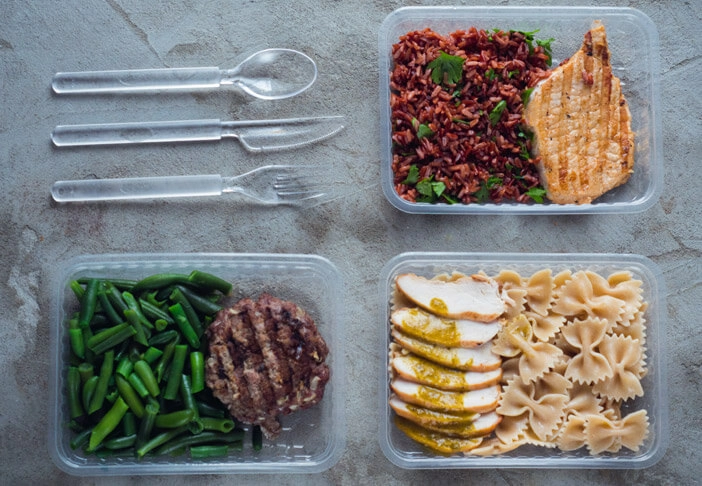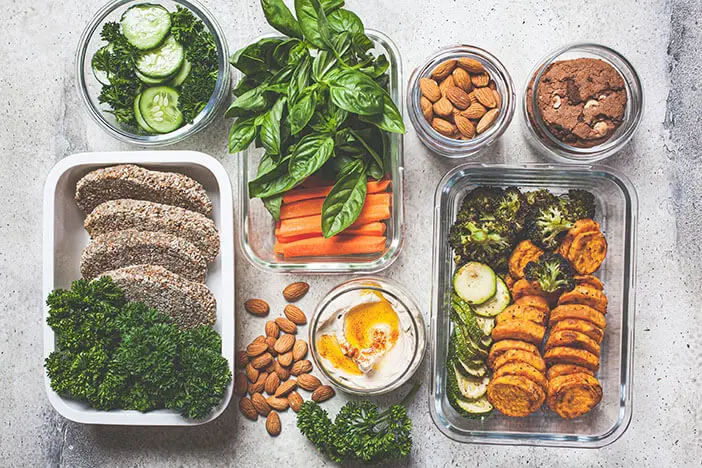- Review – Quiz
- Healthy Cooking Techniques: Choosing the Right Preparation Method
- Why do we buy what we buy?
- Food advertising strategies: look behind the scenes
- Nutrition labels at a glance: Decipher the information on food packaging
- Cooking and shopping healthily – you have to know your stuff!
- The Essentials (brief)
- 5 simple things you can implement
- Your Homework
1. Review - Quiz
If you´re familiar with diets, then you´ll know it too: the Yo-yo Effect. What exactly is it and what can you do about it?
Have you ever stood at the supermarket checkout and realized when you checked out that you bought more than you actually wanted? The range in the supermarket these days is almost endless. And you don’t know what you need and what you want because of all the offers. This makes awareness of a healthy diet all the more important – from shopping to cooking.
But how can we choose the healthiest cooking techniques? What actually influences what we buy? What subtle, often unconscious strategies do companies use to entice us to buy certain products? And how do we decipher the information on the packaging, from nutritional information to the Nutri-Score?
Learn how to make better health decisions in this lesson.
2. Healthy Cooking Techniques: Choosing the Right Preparation Method
Choosing the right cooking technique not only affects the taste but also the nutrients of your meals. Here are various cooking techniques at a glance:
Choosing the right cooking technique can help maximize the nutritional content of your meals while preserving flavor.
3. Why do we buy what we buy?
Our purchasing behavior is influenced by a variety of factors, ranging from personal preferences to social trends. Here we take a detailed look at the psychological aspects of consumer behavior and shed light on why we buy exactly what we buy.
Personal preferences and needs: Personal taste preferences, allergies, ethical considerations and individual lifestyle play a decisive role here. For example, someone who follows a vegan diet increasingly uses plant-based products.
Emotional influences: The way a product is marketed can trigger strong emotional reactions and influence the buying process. For example, foods associated with positive emotions such as joy or nostalgia may be preferred.
Social trends and pressures:The desire to belong and the need to follow the latest trends significantly influence our purchasing decisions. Products that are considered “trendy” may have higher appeal. For example, social media and influencers can have a significant influence on which products are considered popular and desirable.
Brand loyalty: Our relationship with certain brands can be strongly influenced by habit and identification. People tend to buy products from brands they know and trust. Brands with a positive association often have higher customer loyalty.
Purchase impulses through advertising: Creative and engaging advertising campaigns can trigger impulse purchases and stimulate interest in a product.
Price and profitability: Discounts, special offers and perceived value for money can greatly influence purchasing behavior.
These backgrounds are often addressed in advertising strategies. By understanding these psychological aspects of your consumer behavior, you can learn to shop and make decisions more consciously.
4. Food advertising strategies: look behind the scenes
The food industry cleverly uses various advertising strategies to attract attention and increase sales of its products. Only if you know them can you avoid falling into these advertising traps.
4.1 Product placement
Products are specifically showcased to increase their visibility. This can be done in TV shows, movies, or on social media platforms.
Example
For example, the TV series “Stranger Things” features a lot of Coca-Cola, directly linking the brand to 1980s nostalgia and the series’ popular characters.
4.2 Health terms and symbols
This strategy involves using terms like “natural,” “healthy,” or symbols like hearts and leaves on the packaging.
Example
Granola bars that emphasize protein content on their packaging without actually having a high protein content. This suggests a health benefit to you as the focus is on the high protein content. These bars often have a high sugar content – of course not very healthy.
4.3 Colorful Packaging
You’ve probably put something in the supermarket cart that you didn’t want – but the packaging just appealed to you, right? You’re not alone! Bright and colorful packaging should attract our attention and entice you to try out the products and take them with you.
Example
Breakfast cereals like “Froot Loops” rely on bright colors and playful shapes to arouse interest, especially in children, and to give the impression of fun while eating.
4.4 Marketing with Influencers

Well-known personalities or influencers are paid to feature products on their social media profiles. If a fitness influencer regularly shows off a particular protein bar and emphasizes how delicious and healthy it is, this can make followers want to consume the same product to follow suit.
Example
Brands like ESN or More Nutrition rely heavily on influencer marketing. On social platforms such as Instagram, TikTok or Facebook you can quickly find a whole range of men and women who advertise these brands on their channels.
4.5 Limited editions and special offers
Limited availability or time-limited special offers create pressure to purchase immediately.
Example
“Limited Edition” flavors of snacks or drinks that create hype around their uniqueness and increase demand – like the Cola Y300, which was developed together with artificial intelligence.
4.6 Cross-Promotion with popular characters

This strategy involves collaborating with well-known personalities, cartoon characters or superheroes to promote products. Through the positive perception of the personality or figure, this is transferred to the advertised product, especially among young target groups.
Example
An example of this is the collaboration between McDonald’s and popular film characters such as Minions or superheroes.
4.7 Emotional connection through storytelling
This attempts to create an emotional connection with consumers by telling stories surrounding the product. Storytelling makes it possible to associate a brand or product with certain values, experiences or lifestyle aspects. Through such stories, consumers can better identify and build a personal relationship with the product.
Example
Lindt chocolate advertising is well known across all generations. Advertising, especially at Christmas and Easter, tells a story about families celebrating holidays together and enjoying time together. We ourselves often know these sights well and feel connected to the product.
4.8 Social Media challenges and competition
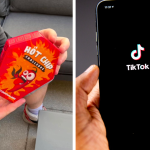
This strategy involves initiating challenges or contests on social media to generate viral attention. Consumer interaction with the product, whether through sharing content or entering contests, spreads the brand message quickly and effectively across social networks.
Example
An example of this is the “Hot Chip Challenge,” which asks people to try particularly spicy snacks and share their reactions. These challenges spread virally and draw attention to specific products or brands in the snack space.
There is not just one factor that influences what we eat and drink – and especially what we want to buy. Rather, there are various factors that can influence our decisions.
Maybe you’re wondering now – rightly so! – whether there is an objective way to identify the healthier alternative. And yes: they exist. The nutritional label!
5. Nutrition labels at a glance: Decipher the information on food packaging

Nutri-Score, nutritional table, pie charts – you can find out a lot about the food on the packaging. It is important not only to know and understand these labels and representations, but also to classify them correctly. This is the only way you can make an informed decision.
5.1 Nutritional table: Comprehensive information at a glance

The nutritional value table is a mandatory label on packaged foods in the EU. This tabular representation provides detailed information about the energy content and amounts of the six main nutrients:
- Fat
- Saturated fatty acids
- carbohydrates
- Sugar
- Protein and
- Salt.
The information is given per 100 g or 100 ml and enables a direct comparison between different products. Some manufacturers supplement the mandatory information with voluntary information per serving.
Advantages
The nutritional table allows you to understand the nutritional composition of a product at a glance. It helps you make informed decisions and compare products based on their nutritional content.
Disadvantages
Without a certain basic knowledge (“How much fat per 100 g is too much?”, “How much energy should I eat per day?”), the nutritional tables are difficult to use in your own case.
5.2 GDA label: guidance for daily needs
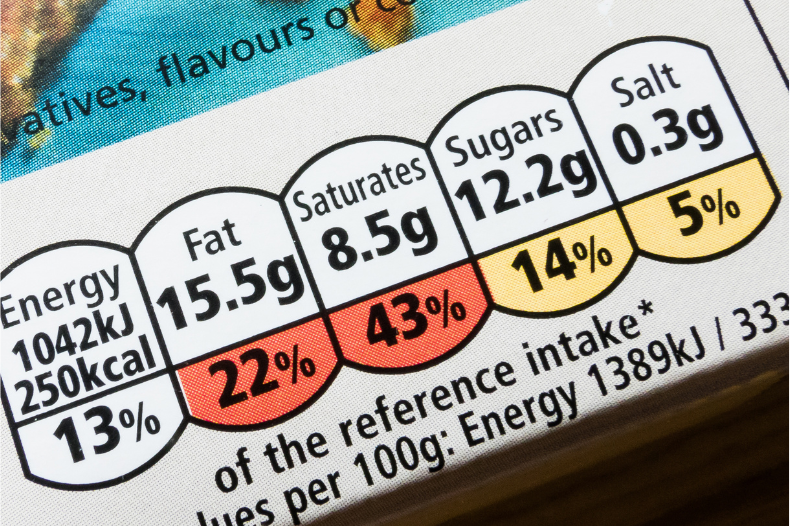
The Guideline Daily Amounts (GDA) is an additional labeling method that is carried out voluntarily on foods. The information refers to reference amounts for the daily intake of energy and selected nutrients. They can be given both per 100 g/ml and per portion and serve as orientation within the daily diet.
Advantages
The GDA labeling offers you practical guidance on how much energy and certain nutrients a food provides in the context of daily needs. This supports a conscious diet in accordance with general nutritional recommendations.
Disadvantages
The labeling requires an additional calorie count per 100 g/ml when stated per serving.
5.3 Nutri-Score: Health assessment through colors
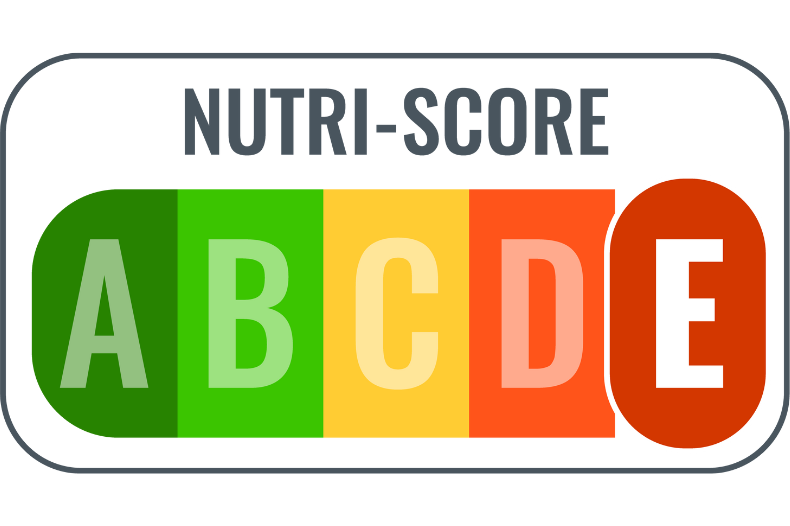
The Nutri-Score is another nutritional labeling system that is placed on the front of food packaging. This evaluation is done using the letters A to E, which are colored from green to red. The Nutri-Score is based on an algorithm that takes different nutrients and components of the food into account. Many unhealthy components result in a red Nutri-Score, while many healthy components result in a green one.
In addition, the Nutri-Score always compares with other products in the same category: a pizza with a spelled base, low-fat cheese and lots of fresh vegetables can achieve a green score, while a conventional ready-made pizza can achieve a red score.
Advantages
The Nutri-Score offers a simple way to evaluate the health quality of a food at a glance. The color coding makes classification easier and allows you to quickly select healthier options.
Disadvantages
Although the Nutri-Score provides helpful guidance, it is important to note that it cannot cover all aspects of a food’s health effects. It does not replace the detailed nutritional table. Without further information, consumers would think that they are eating healthily if they only eat foods with a Nutri-Score A. Of course that’s not true (because then we’d all happily eat vegetable pizza every day). In the same way, healthy foods (olive oil) are also rated with worse scores. Without background knowledge of healthy eating, the score is not very helpful.
5.4 Nutritional and health claims: In-depth insights into the health effects
Nutritional and health claims are voluntary information that manufacturers may make based on scientific findings, e.g. the addition of “rich in protein” or “source of fiber”. This information quickly shows the nutritional properties of a product. They can include both nutritional values and positive health effects.
Advantages
This information allows you to evaluate the food more comprehensively and provides additional information about its potential health benefits. This encourages more conscious choices while shopping.
Disadvantages
Companies are only allowed to make nutritional and health-related claims if it has been scientifically proven and the right amount is in the food.
But food manufacturers often work around these requirements: products for whose main ingredient the health claim cannot be used are now supplemented with substances for which the desired claim is permitted. A yogurt with ‘probiotic’ bacteria, which can no longer be advertised as ‘strengthening the immune system’, is simply enriched with vitamin C and can once again refer to the immune system – in conjunction with this vitamin.
6. Cooking and shopping healthily - you have to know your stuff!
It sounds simpler than it is. You first have to find your way through the jungle of labels and advertising slogans. And that is more difficult than you would think at first glance! The various nutritional labels are all helpful – at least in theory – and can help you make healthier choices. All you need to know is how to interpret these nutrition labels. And how do you prepare these foods in a healthy way? We’ll learn all this in the next lesson!
The Essentials (brief)
- Choosing the right preparation method not only affects the taste but also the nutritional content of the meals. Steaming, grilling, braising, roasting, deep-frying, steaming and blanching are different cooking techniques with advantages and disadvantages.
- Your purchasing behavior is influenced by various factors, including personal preferences, emotional influences, social trends, brand loyalty, advertising and prices.
- Companies use product placement, health terms, colorful packaging, influencer marketing, limited editions, cross-promotion and storytelling to capture consumer attention and increase sales.
- The nutritional table, GDA label and Nutri-Score provide information about the nutritional value of foods. It is important to understand these labels to make informed shopping decisions.
-
5 simple things you can implement
- Explore different cooking techniques and consciously choose methods that maximize the nutritional content of your meals without compromising taste. Experiment with healthier cooking methods like steaming, braising, or grilling.
- Take time to reflect on your own purchasing behavior. Pay attention to what factors influence your decisions, be it personal preferences, emotional influences or social trends.
- Be aware of advertising strategies in the food industry. Question product placement, health terms, colorful packaging and influencer marketing. Learn to recognize advertising tricks to be less prone to impulse purchases.
- Deepen your understanding of nutritional labels such as the Nutrition Facts Table, GDA label and Nutri-Score. Learn how to interpret and compare this information to make informed grocery shopping decisions.
- Be critical of nutritional and health claims on food packaging. Understand that while this information is informational, it can also be used tactically by food manufacturers. Educate yourself about the food you buy and don’t rely solely on this information.
Your Homework
Take a look at your weekly shopping or the food packaging in your pantry. Note what factors influenced your purchasing decisions, be it advertising, social trends or personal preferences. See if you recognize patterns and think about how you can make more conscious decisions.

